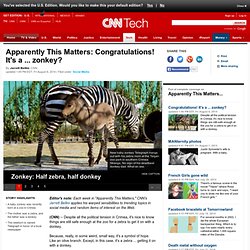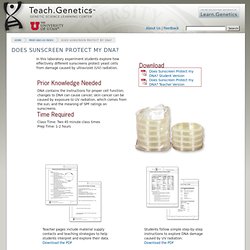

FDA urged to approve 'three-parent embryos' The United States should permit scientists to implant embryos with DNA from three genetic parents into women with certain diseases who otherwise wouldn’t be able to conceive a healthy child, an expert panel said Wednesday.

The technique could open a new frontier in reproductive medicine and upend the fundamental truth of sexual reproduction, which merges DNA from one father and one mother to create a baby. The new procedure, which federal regulators are reviewing, would create an embryo with genetic material from two women and one man. It’s still in the experimental phase and will not be available in fertility clinics for some time. The expert panel is recommending that it be approved only for clinical trials to help women who carry certain grave genetic diseases bear children who are biologically related to them, yet free of the disease.
Such work is already permitted in the United Kingdom. Read more: UK government agency approves editing genes in human embryos Weighing potential risks. Learn Genetics. 2.0%20Incompl.%20Dom. Codom%234518. Genome Editing with CRISPR-Cas9. This is the technology that's just been used to genetically modify a human embryo. Learn.Genetics.utah.edu. Teach.genetics.utah.edu/content/epigenetics/print/Your Environment Your Epigenome.pdf. Basic Genetics. Detecting Duchenne Muscular Dystrophy. Name:___________________________________________Date:_____ The situation you will be dealing with is the following: Mary and John Smith have three children: Daniel, age 5; Alice, age 4; and Michael, age 1.

Mary is two months pregnant. Recently Mary and John noticed that Daniel was having trouble climbing the stairs. He also complained several times that he was really tired after playing tag with his sister. Daniel’s doctor suggested some medical tests, which brought the family some bad news: Daniel has a disease called Duchenne muscular dystrophy (DMD). Mary and John had never heard of DMD before, so they asked the doctor a lot of questions and went to the library for more information. Usually boys with DMD are healthy until the age of 4 or 5, at which time their muscles start to weaken.
Obviously, Mary and John were very upset by this news about Daniel. You took the Smith's blood samples and isolated DNA from the white blood cells in each of them. 1. 2. 3. Assignment 8, page 1. Using Karyotypes To Diagnose Genetic Disorders. Sometimes chromosomes are incorrectly distributed into the egg or sperm cells during meiosis.

When this happens, one cell may get two copies of a chromosome, while another cell gets none. Incorrect distribution of chromosomes is called nondisjunction. If a sperm or egg cell with too many or too few chromosomes participates in fertilization, it will produce a zygote with too many or too few chromosomes. A zygote with 3 copies of a chromosome is said to have trisomy (pronounced TRY-so-mi). A zygote that is missing a chromosome is said to have monosomy (MOH-no-so-mi).
Most of the time, autosomal (non-sex chromosome) trisomy and monosomy are lethal because the zygote ends up with too much or too little genetic information. When monosomy or trisomy involves sex chromosomes, individuals usually survive and many are quite healthy. PLSC 431/631 - Course Topics. Apparently This Matters: New baby zonkey. New baby zonkey Telegraph hangs out with his zebra mom at the Taigan zoo park in southern Crimea.

Strange. No sign of his deadbeat donkey dad. A-Trihybrid-Cross-Example-Using-Mendel%E2%80%99s-Sweet-Peas. How Mendel's pea plants helped us understand genetics - Hortensia Jiménez Díaz. Genetics Practice Problems. Genetics Practice Problems You may type in your own answers, then check to see if you were right.

If you’re totally stumped, you can tell the computer to show you the answer to a particular question. Monohybrid Cross: In humans, brown eyes (B) are dominant over blue (b)*. A brown-eyed man marries a blue-eyed woman and they have three children, two of whom are brown-eyed and one of whom is blue-eyed. (* Actually, the situation is complicated by the fact that there is more than one gene involved in eye color, but for this example, we’ll consider only this one gene.) Testcross: In dogs, there is an hereditary deafness caused by a recessive gene, “d.” Incomplete Dominance: Note: at least one textbook I’ve seen also uses this as an example of pleiotropy (one gene – multiple effects), though to my mind, the malaria part of this is not a direct “effect” of the gene. A photo, taken by Dr. Does Sunscreen Protect my DNA? In this laboratory experiment students explore how effectively different sunscreens protect yeast cells from damage caused by ultraviolet (UV) radiation.

DNA contains the instructions for proper cell function; changes to DNA can cause cancer; skin cancer can be caused by exposure to UV radiation, which comes from the sun; and the meaning of SPF ratings on sunscreens. Class Time: Two 45 minute class times Prep Time: 1-2 hours Does Sunscreen Protect my DNA? Student Version Does Sunscreen Protect my DNA? Teacher pages include material supply contacts and teaching strategies to help students interpret and explore their data. Practicing Punnett Squares.